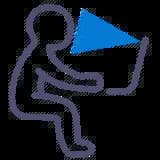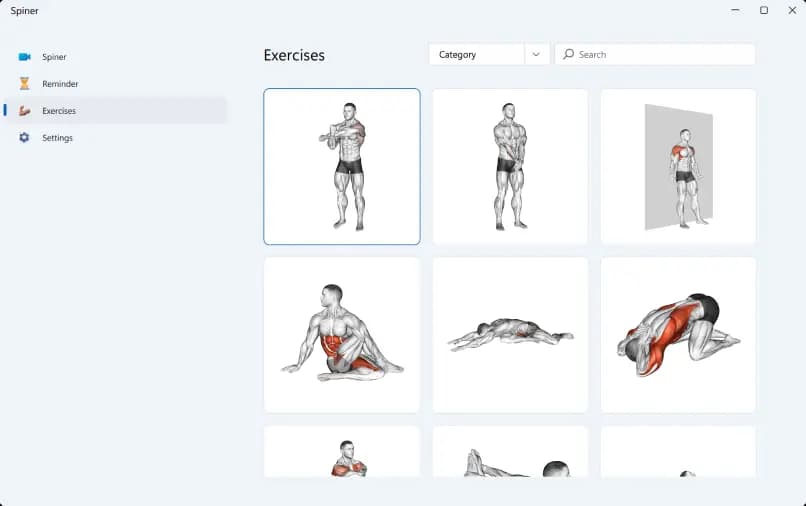
How It Works?


Launch Spiner
It measures your distance from the webcam.



Customize Your Settings
Choose your ideal sitting posture and set the frequency of distance checks. Adjust the notification trigger based on your preferred face-to-screen distance.

Minimize Spiner. It will continue to monitor and alert you if you lean too forward.
Spiner is fully adjustable
Check every...
Choose camera
Keyboard Shortcuts
Distance to trigger
Notifications text
Warning / Error

Avoid Pain:
Proper Posture for Better Health!
Forward Head Posture (FHP), commonly referred to as "Nerd Neck" or "Tech Neck", is a prevalent issue stemming from the modern lifestyle, characterized by extensive screen time on computers, smartphones, and other devices. It involves the head projecting forward of the cervical spine, leading to an imbalance between underactive and overactive muscles in the neck and shoulder region (Patwardhan et al., 2018; Clark et al., 2014).
Health Implications of FHP
Muscle Imbalances
Underactivity in deep neck flexors and overactivity in upper trapezius and sternocleidomastoid, leading to neck strain and discomfort.
Cervicogenic Headaches
Cervicogenic Headaches: Caused by overactive muscles and trigger points in the upper cervical spine due to FHP (Barnherzig & Kingston, 2019).
TMJ Disorders
FHP alters the muscle dynamics around the neck and jaw, increasing pain and dysfunction in the TMJ (Chaves et al., 2014).
Neck Tightness/Pain
Arises from increased tension in the muscles above the hyoid bone, leading to discomfort and swallowing difficulties (Zheng et al., 2012).
Shoulder Issues
Shoulder Issues: Associated with rounded shoulders and impaired movement patterns, resulting in shoulder pain and impingement (Bayattork et al., 2019).

Respiratory Inefficiency
FHP affects diaphragm function, leading to compensatory overactivity of accessory respiratory muscles and disrupted normal breathing patterns (Okuro et al., 2011).
FHP is exacerbated by poor posture maintained during extensive screen time, gaming, and texting. The COVID-19 pandemic has amplified these issues as more people are confined at home, leading to increased incidences of FHP (Bowles, 2020). The "text neck" phenomenon, where looking down at phones for extended periods exacerbates FHP, has also been highlighted as a significant health concern (Hansraj, 2014).
Next features
for better sitting
Exercises
Easily filter exercises by body region and save your favorite ones for quick access.

Reminders
Spiner also allows you to set fixed-time reminders beyond the main distance notifications. These reminders can prompt activities such as looking out of a window or displaying pre-selected exercises.

FAQ & Support
How can I change my original position without triggering a notification, for example, if I stand up from the desk and come back?
I want to just pause notifications for some time. How can I do that?
How does Spiner know the distance from the camera?
Got any more questions?
100% Privacy Protections

Local Processing
All video processing occurs locally on your device, ensuring privacy.

No Video Transmission
The camera's video feed is not transmitted or shared with any third parties.

Privacy by Design
The application is specifically designed to prioritize user privacy and follows industry best practices.

Start sitting better today
After trial subscription starts on 10 EUR / month
No credit card required
Sources
An, J. S., Jeon, D. M., Jung, W. S., Yang, I. H., Lim, W. H., & Ahn, S. J. (2015). Influence of temporomandibular joint disc displacement on craniocervical posture and hyoid bone position. American Journal of Orthodontics and Dentofacial Orthopedics, 147(1), 72-79. doi:10.1016/j.ajodo.2014.09.015
Bayatorkt, M., Seidi, F., Minoonejad, H., McClure, P., & Mozafaripoor, E. (2019). Intra-rater and inter-rater reliability and agreement of the scapular dyskinesis test in young men with forward head and round shoulder posture. Journal of Rehabilitation Sciences and Research, 6(4), 169-173.
Barmherzig, R., & Kingston, W. (2019). Occipital neuralgia and cervicogenic headache: Diagnosis and management. Current Neurology and Neuroscience Reports, 19(5), 20. doi:10.1007/s11910-019-0937-8
Berkhout, A. L., Hendriksson-Larsen, K., & Bongers, P. (2004). The effect of using a laptop station compared to using a standard laptop PC on the cervical spine torque, perceived strain and productivity. Applied Ergonomics, 35(2), 147-152. doi:10.1016/j.apergo.2003.11.008
Borhany, T., Shahid, E., Siddique, W. A., & Ali, H. (2018). Musculoskeletal problems in frequent computer and internet users. Journal of Family Medicine and Primary Care, 7(2), 337-339. doi:10.4103/jfmpc.jfmpc_326_17
Bowles, N. (2020, March 31). Coronavirus ended the screen-time debate. Screens won. The New York Times. https://www.nytimes.com/2020/03/31/technology/coronavirus-screen-time.html
Cuellar, J.M. & Lanman, T.H. (2017). “Text neck”: an epidemic of the modern era of cell phones? The Spine Journal, 17, 901-902.
Chaves, T. C., Turci, A. M., Pinheiro, C. F., Sousa, L. M., & Grossi, D. B. (2014). Static body postural misalignment in individuals with temporomandibular disorders: a systematic review. Brazilian Journal of Physical Therapy, 18(6), 481-501. doi:10.1590/bjpt-rbf.2014.0061
Clark, M. A., Lucett, S. C., & Sutton, B. G. (2014). NASM Essentials of Corrective Exercise Training, 1st ed. revised. Jones & Bartlett Learning.
Damasceno, G. M., Ferreira, A. S., Nogueira, L. A. C., Reis, F. J. J., Lara, R. W., & Meziat-Filho, N. (2018). Reliability of two pragmatic tools for assessing text neck. Journal of Bodywork and Movement Therapies, 22(4), 963-967. doi:10.1016/j.jbmt.2018.10.007
Dimitriadis, Z., Podogyros, G., Polyviou, D., Tasopoulos, I., & Passa, K. (2015). The reliability of lateral photography for the assessment of the forward head posture through four different angle-based analysis methods in healthy individuals. Musculoskeletal Care, 13(3), 179-186.
Fernandez-de-las-Penas, C., Galan-del-Rio, F., Alonso-Blanco, C., Jimenez-Garcia, R., Arendt-Nielsen, L., & Svensson, P. (2010). Referred pain from muscle trigger points in the masticatory and neck-shoulder musculature in women with temporomandibular disorders. The Journal of Pain, 11(12), 1295-1304.
Gillespie, R. M. (2002). The physical impact of computers and electronic game use on children and adolescents, a review of current literature. Work, 18(3), 249-259.
Gustafsson, E., Thomee, S., Grimby-Ekman, A., & Hagberg, M. (2017). Texting on mobile phones and musculoskeletal disorders in young adults: A five-year cohort study. Applied Ergonomics, 58, 208-214. doi:10.1016/j.apergo.2016.06.012
Hansraj, K. K. (2014). Assessment of stresses in the cervical spine caused by posture and position of the head. Surgical Technology International, 25, 277-279.
Hong, S. W., Lee, J. K., & Kang, J. H. (2019). Relationship among cervical spine degeneration, head and neck postures, and myofascial pain in masticatory and cervical muscles in elderly with temporomandibular disorder. Arch Gerontol Geriatr, 81, 119-128. doi:10.1016/j.archger.2018.12.004
Janda, V. (2002). Muscles and motor control in cerviogenic disorders. In: Grant, R. ed. Physical Therapy of the Cervical and Thoracic Spine. Churchill Livingstone.
Kenney, W., Wilmore, J., Costill, D. (2015). Physiology of Sport and Exercise, 6th Ed. Human Kinetics.
Kim, S.Y., Kim, N.S., Kim, L.J. (2015). Effects of cervical sustained natural apophyseal glide on forward head posture and respiratory function. Journal of Physical Therapy Science, 27, 1851-1854.
Mani, K., Provident, I., & Eckel, E. (2016). Evidence-based ergonomics education: Promoting risk factor awareness among office computer workers. Work, 55(4), 913-922. doi:10.3233/WOR-162457
Mingels, S., Dankaerts, W., van Etten, L., Thijs, H., & Granitzer, M. (2016). Comparative analysis of head-tilt and forward head position during laptop use between females with postural induced headache and healthy controls. Journal of Bodywork and Movement Therapies, 20(3), 533-541. doi:10.1016/j.jbmt.2015.11.015
Okuro, R. T., Morcillo, A. M., Ribeiro, M. A., Sakano, E., Conti, P. B., & Ribeiro, J. D. (2011). Mouth breathing and forward head posture: effects on respiratory biomechanics and exercise capacity in children. Brazilian Journal of Pulmonology, 37(4), 471-479. doi:10.1590/s1806-37132011000400009
Olszewska, E., Tabor, P., & Czarniecka, R. (2018). Magnitude of physiological curvatures of the spine and the incidence of contractures of selected muscle groups in students. Biomedical Human Kinetics, 10, 31-37.
Patwardhan, A. G., Khayatzadeh, S., Havey, R. M., Voronov, L. I., Smith, Z. A., Kalmanson, O., . . . Sears, W. (2018). Cervical sagittal balance: a biomechanical perspective can help clinical practice. European Spine Journal, 27(Suppl 1), 25-38. doi:10.1007/s00586-017-5367-1
Pettit, N. J. & Auvenshine, R. C. (2018). Change of hyoid bone position in patients treated for and resolved of myofascial pain. Cranio, 31, 1-17.
Pop, M.S., Mihancea, P., & Debucean, D. (2018). Posture optimization- Is it the key to myofascial neck pain relief? Archives of the Balkan Medical Union, 53(4), 573-579.
Roussouly, P., & Pinheiro-Franco, J. L. (2011). Sagittal parameters of the spine: biomechanical approach. European Spine Journal, 20 Suppl 5, 578-585. doi:10.1007/s00586-011-1924-1
Simons, D. G., Travell, J. G., Simons, L. S. (1999). Travell & Simons' myofascial pain and dysfunction: Upper half of body. Lippincott Williams & Wilkins.
Stone, M. A., Osei-Bordom, D. C., Inman, R. D., Sammon, C., Wolber, L. E., & Williams, F. M. (2015). Heritability of spinal curvature and its relationship to disc degeneration and bone mineral density in female adult twins. European Spine Journal, 24(11), 2387-2394. doi:10.1007/s00586-014-3477-6
Tsang, S., Szeto, G., & Lee, R. (2013). Normal kinematics of the neck: The interplay between cervical and thoracic spines. Manual Therapy, 18(5), 431-437.
Zafar, H., Nordh, E., & Eriksson, P. O. (2000). Temporal coordination between mandibular and head-neck movements during jaw opening-closing tasks in man. Archives of Oral Biology, 45(8), 675-682.
Zheng, L., Jahn, J., & Vasavada, A. N. (2012). Sagittal plane kinematics of the adult hyoid bone. Journal of Biomechanics, 45(3), 531-536. doi:10.1016/j.jbiomech.2011.11.040